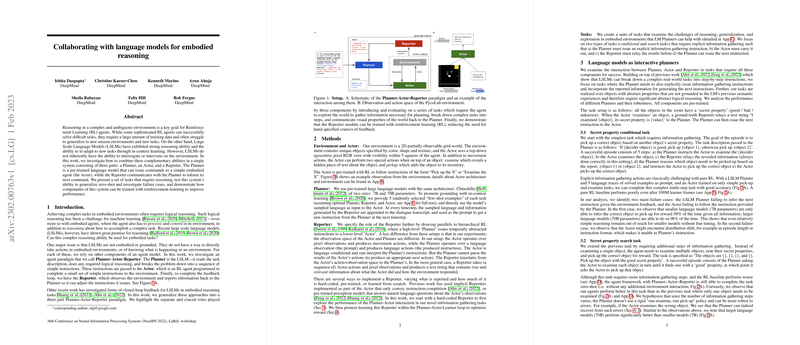Collaborative Reasoning in Embodied Systems via LLMs
The paper "Collaborating with LLMs for Embodied Reasoning" presents a novel approach to integrating Large Scale LLMs (LSLMs) with reinforcement learning agents in embodied environments. This integration is designed to leverage the logical reasoning capabilities of LSLMs while overcoming their limitations in direct interaction with complex environments. The authors propose a sophisticated system architecture consisting of three components: the Planner, the Actor, and the Reporter. This essay discusses the methodology, empirical evaluations, and implications of this approach, offering insights into its future potential.
Overview of the Planner-Actor-Reporter Framework
The authors introduce a unique three-part framework called the Planner-Actor-Reporter paradigm. This system aims to combine the planning capabilities of LSLMs with the environmental interaction capabilities of RL agents. In this system:
- Planner: The Planner component is a pre-trained LLM responsible for interpreting task descriptions, conducting logical reasoning, and generating a sequence of simple, actionable instructions.
- Actor: The Actor executes the given instructions within a partially observable 2D grid-world, performing movements and actions based on environmental feedback.
- Reporter: The Reporter facilitates the feedback loop by translating environmental states and Actor actions into descriptive reports for the Planner to evaluate and adjust its strategy accordingly.
This triadic model enhances the ability to perform embodied reasoning, overcoming the limitations of traditional RL models that require extensive training data for complex tasks and struggle with generalization.
Empirical Evaluation and Outcomes
The authors evaluate their proposed system through a series of tasks that demand logical reasoning, generalization, and exploration. Key findings from the paper include the following:
- Effectiveness in Reasoning Tasks: The integrated system effectively performs tasks that require sequential reasoning, such as determining the 'secret property' of objects through a combination of exploration and deduction.
- Zero-Shot Generalization: The system demonstrates impressive zero-shot learning abilities by completing tasks without prior environment-specific training, relying instead on pre-trained knowledge and a few examples.
- Robustness and Error Recovery: Larger models like the 70B parameter Chinchilla demonstrated robust reasoning and error recovery capabilities. The Planner was able to adapt to mistakes in both Actor execution and Reporter feedback, indicating high operational resilience.
Implications and Future Directions
This research highlights significant practical and theoretical implications in the domain of AI and embodied intelligence:
- Improved AI Collaboration: The triadic system could lead to more effective human-AI collaboration, particularly in tasks where logical reasoning and environmental interaction need to be synergized.
- Potential for Broader Applications: These types of systems could be deployed in various applications, from autonomous robots in dynamic environments to intelligent assistants handling complex decision-making scenarios.
- Scalability and Efficiency: Future research can explore scalability concerns, optimizing computational efficiency, and improving the fidelity of environment interactions, particularly as the Reporter module becomes more autonomous.
In conclusion, the paper demonstrates critical advancements in integrating LLMs with embodied agents, bridging the gap between logical reasoning tasks and direct environmental interactions. This work provides a promising foundation for future research focused on enhancing AI performance in multifaceted, dynamic environments.
